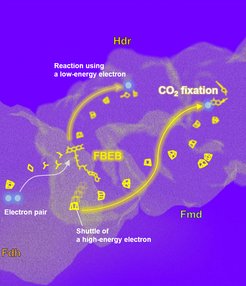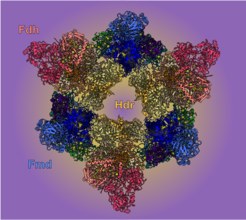Wired for Efficiency: How methanogenic microbes manage electrons
A specialized enzyme machinery enables methanogenic microorganisms to thrive under extreme energy limitation
Methanogenic archaea use sophisticated enzyme systems to live in energy-limited anoxic environments. A key mechanism for saving energy is electron bifurcation, a reaction that ‘splits’ the energy of a pair of electrons, making one more strongly reducing at the expense of the other. Researchers from the Max Planck Institutes for Terrestrial Microbiology (Marburg) and Biophysics (Frankfurt am Main) have discovered a massive enzyme complex from a methanogenic archaeon that directly transfers electrons from the electron bifurcation reaction to CO2 reduction and fixation. Their detailed insights into these efficient energy-transforming processes may open new possibilities for sustainable biotechnological development.

An estimated 1 billion tons of methane is produced each year by anaerobic microorganisms called methanogenic archaea. As methane is a potent greenhouse gas, increasing atmospheric concentrations of methane threaten lives and livelihoods. On the other hand, capturing the methane produced biologically by anaerobic digestion of wastes and wastewater may represent a renewable source of fuel. Therefore, understanding the mechanisms of microbial methane formation has the potential to stimulate and support environmental conservation efforts.
Methanogenic archaea successfully compete by performing methanogenesis, one of the final steps of anaerobic breakdown of organic nutrients, often under extreme conditions. Most methanogenic archaea produce methane from carbon dioxide (CO2) and hydrogen gas (H2) via the methanogenic cycle, involving multiple enzyme reactions. In typical methanogenic habitats, this reaction releases only a small amount of energy, so methanogens need highly efficient enzyme systems to thrive in such energy-limited environments.
A particularly sophisticated step of the methanogenic cycle is called flavin-based electron bifurcation (FBEB). In this reaction the energy of a pair of electrons is split, so that one electron becomes more strongly reducing at the expense of the other. It was assumed that methanogens transfer the high-energy electron from this reaction to fix CO2 via a small electron carrier protein, ferredoxin, which diffuses freely in the cell.
Surprisingly, a research team at the MPI for Terrestrial Microbiology (Marburg) and the MPI of Biophysics (Frankfurt) has shown that such an electron carrier is not needed to transfer electrons from FBEB to CO2 reduction. The researchers purified enzyme complexes consisting of formate dehydrogenase (Fdh), heterodisulfide reductase (Hdr) and formylmethanofuran dehydrogenase (Fmd) from the methanogenic archaeon Methanospirillum hungatei. This species, as well as many other methanogens, is often found in anaerobic digesters that treat organic wastes, such as municipal wastewater or industrial waste.
The researchers characterized the function of the enzyme complexes with enzyme assays and solved structures by cryogenic electron microscopy (cryo-EM). The structures revealed that the enzymes catalyzing the last and first steps of the methanogenic cycle form a massive complex, thereby directly connecting two steps, namely the formate-driven FBEB and reduction of CO2, without using the diffusible electron-carrier protein ferredoxin.

“Our structural analysis revealed a gigantic enzyme complex,” says Tomohiro Watanabe, lead author of the study. “An electron-transfer chain protein, polyferredoxin, forms a conductive pathway that leads the high-energy electrons from FBEB directly to CO2 reduction, rather than via a soluble carrier. This means there is less opportunity to lose these precious electrons.”
Structural comparisons and previously published interaction assays suggest that such higher-order structures of the Hdr and Fmd complexes could be common in diverse methanogenic archaea. The structures also provided new insight into the fine-tuned mechanism of FBEB. Corresponding author Bonnie Murphy explains: “The method of cryo-EM allows us to use image classification to solve structures of different conformational states present within the same sample. In this case, we found that two different conformational states of the complex differed by a large rotation of a portion we are calling the ‘mobile arm’. By rotating between these two states, the complex controls electron flow into and out of the FBEB site”.
Together, these findings help us to understand how the energy metabolism of methanogenic archaea is fine-tuned for efficiency: by controlling electron flow into and out of FBEB and by allowing direct transfer of high-energy electrons for CO2 fixation. This knowledge will be helpful in designing strategies to reduce greenhouse gas emissions, and may allow wider application of electron bifurcation in biotechnology.













